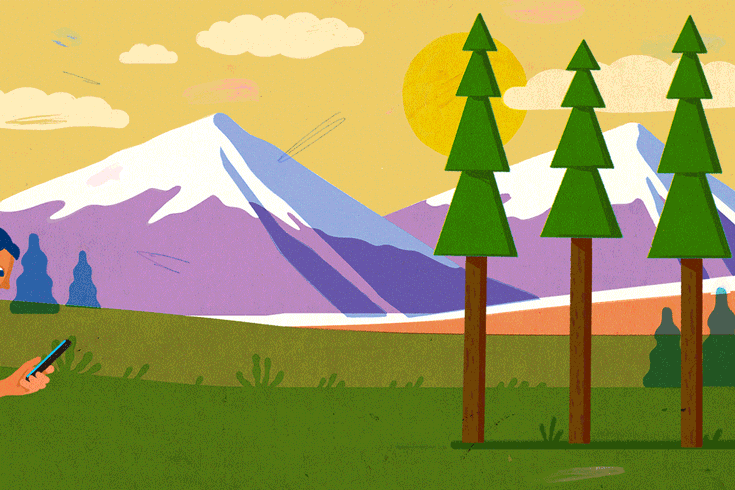At 8:30 a.m. on a summer weekend, the parking lot for Joffre Lakes Provincial Park, a few hours’ drive north of Vancouver, is already full. A couple dozen visitors—a cross-section of local residents and international tourists, some in hiking gear and some in street clothing—have lined up by the outhouses and porta-potties. A park ranger stands by the trailhead, asking visitors to leave behind any food containers (usually, it seems, Tim Hortons takeout). And a woman grips two golf irons, using them as makeshift hiking poles for her journey up the five-kilometre trail that leads visitors past three picturesque, glacier-fed lakes.
At the last lake, a group is spread out on a channel of boulders—a popular spot from which to view the mountains and glacial debris that wrap around the water. The sun is shining, and nearly everyone is taking photos. A woman wearing a pink top wades into the water and climbs onto a partially submerged boulder, inviting her friend to take a photo. But her foot slips on the wet surface, and she tumbles into the lake. Everyone pauses. A moment later, she emerges from the water, smiles, and raises her hands in victory. Relieved, the crowd erupts in applause.
The tense scene is representative of a new relationship with public parks—one that, with its prioritization of snapshots and social media, requires little in the way of outdoor skill or knowledge. Joffre is at the epicentre of this cultural change: the hashtag #JoffreLakes pulls up over 64,000 images and videos on Instagram, and many flock to Joffre to have their photo taken on what they call the “selfie log”—a tree trunk that extends from the shore into one of the lakes—against a backdrop of forest and mountains. Between May and September 2011, around 52,000 people visited the park; in that same period in 2018, nearly 150,000 people did. When the parking lot is full, people park illegally on the shoulder of the highway and walk, sometimes four abreast, to the park’s entrance. Police struggle to control the crowds—one RCMP officer called it “driver anarchy”—and warn that a serious accident could happen on the highway. There are also no garbage cans at Joffre, as is the case in most provincial parks, and littering is an ongoing issue. Last year, two hikers collected around forty pounds of discarded containers, beer cans, and camping equipment that had been hidden next to the trail.
For years, natural reserves have been seen as havens from the modern world, places where quotidian life gives way to quiet reflection and contemplation, often in relative isolation. But social media has disrupted the way we interact with the environment. With the right hashtag, anyone can view thousands of potential destinations—and choose which to visit based on aesthetics alone. A single social-media post can expose lesser-known or isolated places to the world. And that means good places can no longer hide. “They used to be local parks,” says Mairi Welman, head of communications for the District of North Vancouver, which manages two popular parks near the city. “But now we’re starting to see international visitors coming—and those parks were never designed to handle those kinds of numbers.” The influx has resulted in a host of problems, from woefully unprepared hikers getting hurt to people “using the environment as a bathroom.” And then there’s the parking: “There have literally been screaming matches and fist fights over parking spots,” she says. “It can be like a shopping mall at Christmas.”
The commotion at Joffre is not an isolated phenomenon. Last summer, chaos broke out at a farm an hour’s drive southwest of Toronto after images taken by visitors in a field of sunflowers went viral on Instagram. The owners—who had been charging a fee to visit the field and expecting the typical hundred-or-so visitors—were overwhelmed by several thousand unexpected customers on a single day. Police were called to shut the operation down after impatient sightseers trespassed onto farm property and cars crashed on the nearby highway. In Thailand, last fall, authorities indefinitely closed Maya Bay—the picturesque cove featured in the 2000 Leonardo DiCaprio movie The Beach—after discovering that tourists had destroyed an estimated 80percent of its coral reef, which was damaged by boat anchors, trampling visitors, and nonbiodegradable sunscreen. And, in Iceland, many environmentalists say a massive influx of social-media-fuelled travellers is threatening fragile ecosystems: the hordes of tourists are flattening delicate beds of moss.
Some industries see opportunity in courting social-media attention. Museums, for example, are increasingly allowing—even encouraging—photographs of their exhibitions. Last spring, the Art Gallery of Ontario hosted Yayoi Kusama’s Infinity Mirrors, a travelling exhibit with exceptionally Instagrammable qualities: a series of rooms decorated with mirrors, lights, and fantastical backdrops. Every visitor was granted thirty seconds inside each room—enough time to snap a selfie. Over a three-month run at the AGO, the show was visited by more than 165,000 people (and, in November, the gallery started the hashtag #InfinityAGO as part of a bid to fundraise $1.3million to purchase one of the rooms). While some saw Kusama’s success as a testament to the internet’s ability to inspire the public to engage with high art, others were less convinced. “For all the depth of Kusama’s thinking . . . the social media profile of her biggest hits seems an irresistible prompt for a surface skim,” lamented the Toronto Star’s art critic. Many outdoor enthusiasts voice similar concerns for Canada’s public parks: engagement is growing, but it’s vapid, devoid of the deeper reflection that being in nature is meant to inspire. Whether it likes it or not, the park world is welcoming a surge of new visitors who don’t conform to—or understand—its etiquette.
Canada’s stunning natural landscapes have long been celebrated as a defining attribute. And perhaps no province has more closely aligned its identity to the outdoors—old-growth forests, towering mountains, and ocean waters—than BC, where the tagline “Beautiful British Columbia” appears on nearly every licence plate. Yet exploring such places has traditionally been the reserve of a self-selected group of adventurers whose backcountry know-how and environmental ethic were forged in outdoor clubs or passed down through generations. For years, BC Parks catered to their needs, assuming a certain level of environmental values and skill.
Over the past decade, the provincial agency—like its counterparts across the country—has started courting more visitors as part of its mandate to manage natural environments for the “enjoyment of the public.” It cut parking fees in 2010 and expanded its land base. In 2014, it began a major trail upgrade on Joffre, making it far more accessible—even to those in flip-flops or heels. At the same time, as part of an effort to stimulate the economy, the province doubled down on its tourism industry. It now allocates about $51 million a year to Destination BC, a provincial tourism agency that has skilfully promoted the province’s natural landscapes using paid social-media influencers and other digital-media strategies. For years, the organization has promoted the hashtag #ExploreBC, which has now been affixed to over 4.5 million photos and videos on Instagram.
Today, the province’s busiest parks are marquee attractions for international visitors, and they can feel as cosmopolitan as big-city malls. But the government was not prepared for this level of virality—and many critics say it isn’t making the requisite investments. BC Parks generally continues to operate as it always has: with unappealing, boilerplate signage (in English only) and little in the way of educational programming or outreach. With a 2018/19 budget of $40.5 million, the provincial agency has approximately $2.88 for every hectare of protected land—while Alberta Parks and Parks Canada have about $24 and $38 respectively.
In Welman’s view, demand for parks and outdoor experiences is primed for even more growth, and it’s incumbent on park administrators to adapt. Near Vancouver, in Deep Cove—which features Quarry Rock, an outcropping located in a tiny park—the district has restricted parking for tour buses and limited the number of people who can stand on the rock at a given time, out of fear that someone may fall off. “We’ve had days where there are around 150 people out there,” says Welman. “Seventy is still a lot.”
At Lynn Canyon Park, which attracts an estimated 500,000 visitors a year, the district has created a new signage program to underscore the dangers of cliff jumping. Between 1985 and 2016, twenty-four people have accidentally died jumping or falling into the canyon. Welman and her colleagues worry that a desire to show off on social media is encouraging people to act recklessly. There are, she says, dozens of videos on YouTube that “glamorize” cliff jumping. Vancouver-based vlogging collective High On Life, for example, published a popular video of members jumping fifty metres into the canyon. This summer, two founders of the group and another YouTuber lost their lives when they were swept over a thirty-metre section of Shannon Falls, one of BC’s largest waterfalls.
Lynn Canyon’s new signs are brightly coloured and straightforward. One lists the number of people who have been seriously injured or killed at various spots. Another takes the form of a glib text exchange between two friends: “That was worth the spinal damage.” “Said no one ever.” While signage hasn’t stopped people from jumping, it does signal a willingness on the part of parks management to try something new. And according to Mike Danks—head of the search-and-rescue team North Shore Rescue—it has contributed to “a huge increase” in awareness of the safety risks, though it’s “still not enough.” Cliff jumping, he fears, has become “kind of a trendy” thing to do.
With their close proximity to Vancouver, the North Shore mountains are a haven for hiking expeditions, and the rescue team is responding to more and more calls from inexperienced hikers. In2018, North Shore Rescue responded to 144 calls—an increase from the ninety to 100 calls that were typical before 2015. In Danks’s estimation, there is a clear link between increased call volume and the adoption of social media, which has attracted an international crowd. Danks recalls a German tourist in 2017 who was inspired by an Instagram post to hike alone to Saint Mark’s Summit—a peak in Cypress Provincial Park with spectacular views of Howe Sound. The online photo had shown dry conditions, but the woman, who was hiking alone, soon found herself unexpectedly trudging through snow. After losing her way, she slid down a gully, desperately trying to make it to the water. Eventually, she found herself stuck on the edge of acliff and called for help; North Shore Rescue sent a helicopter team to pick her up. By then, “she actually wore a hole in her jeans from sliding so far,” says Danks.
With certain parks bursting at the seams, many long-time outdoor enthusiasts worry that more remote areas are at risk of being discovered and exploited. In 2017, for example, a secluded hot spring and hiking area two hours’ drive east of Joffre was closed for the summer after unprecedented littering attracted bears. Because a number of other places in the country are thought to risk a similar fate, geo-tagging certain areas or hikes online is now a serious faux pas in the outdoor community.
Veteran park frequenters are understandably wary of new visitors, who might disrupt a park’s peaceful isolation or even litter it with Tim Hortons cups. But much of the hand wringing in the outdoor community also seems to revolve around naked displays of selfie culture. There’s a tangible sense of moral judgment—a perception that people who engage in outdoor photoshoots aren’t appreciating nature in the right way. Yet documenting adventure has long been a mainstay of the outdoor world: even today, a well-framed image of someone on top of a mountain (or a well-worn Patagonia jacket in the closet) can confer status. So why does posting asimilar symbol on social media cause such offence?
Herk Anwer, a Surrey, BC, resident, decided to hike through Joffre for the first time after seeing photos of the lakes on Instagram. After his first visit to the last lake, he said he would plan a similar hike every weekend. The crowdedness of the park was not ideal, he said, but he also appreciated that others were enjoying the experience. “It’s better than spending money on stupid things. And it’s kind of healthy, right? So why not?” Not everyone is lucky enough to have grown up backcountry camping or spending time in cottage country. And a conservation ethic is learned, not innate.
Last September, a group of BC municipalities concerned about the health of wildlife and an increased risk of wildfires in the area called on the government to make funding for natural areas “commensurate” with the influx of visitors caused by its tourism marketing. Going forward, BC Parks could also look to other agencies, such as Parks Canada, for inspiration on how to handle newer visitors. On social media, for example, Parks Canada has used colourful illustrations to warn people against feeding wildlife or littering. It also launched a“hidden gems” campaign in 2017, featuring a smartphone app encouraging people to visit lesser-known parks and historical sites. At a place like Joffre, that kind of approach in conjunction with a system in which visitors can reserve time at the park (a solution that has been suggested by a nearby municipality) could spread out visitation and address the highway-parking issue—a serious liability for the province. But, perhaps more than anything, BC Parks could make significant investments in staffing and educational programming, ensuring that lessons on environmental ethics and outdoor safety are shared in multiple languages. With the right investments, BCParks could turn Joffre and places like it into training grounds for new hikers. Concentrating visitation, rather than allowing it to disperse further afield, could help ensure the long-term health of the province’s parks system.
Despite it being a holiday weekend, there were only two park rangers on hand during my visit to Joffre last summer. Visitors clogged the trail and queued up with their phones and cameras. For some, it was likely their first time in a pristine alpine environment after years of living in the Lower Mainland. Overwhelmed by the crowds, the two rangers spent much of the day rushing to offer crash courses in environmental stewardship: stay on the trail, don’t feed wildlife, don’t litter. At one point, a ranger vaulted over the ridge at the farthest lake and assisted the woman in the pink shirt who had fallen off the rock: she had cut her foot in the fall. A friend piggybacked her to the parking lot as the ranger led the way.





